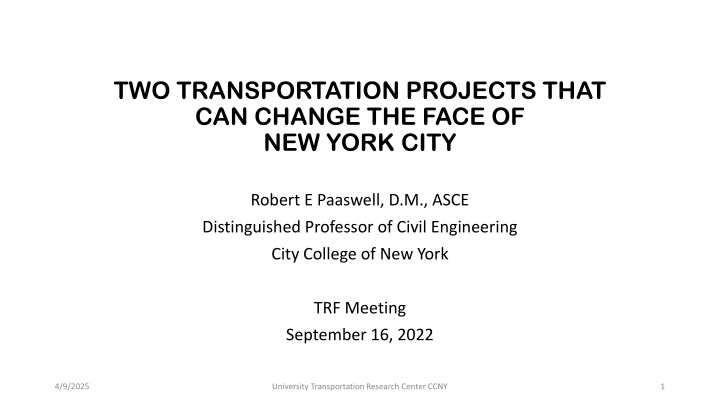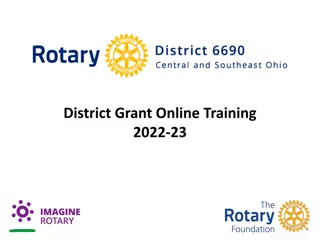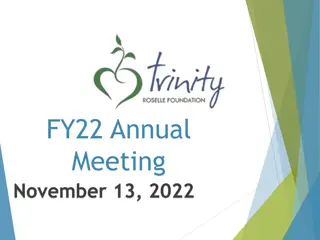
Transportation Projects Transforming New York City
Explore how two transportation projects, Penn Station Renewal and Congestion Charges, are poised to revolutionize New York City's urban landscape. Delve into the implications of these initiatives on commuter patterns, ridership numbers, and the overall development of the city post-pandemic. Uncover key questions surrounding the modernization of Penn Station and the effectiveness of congestion charges in reducing traffic in Manhattan. Gain insights into the evolving transportation dynamics shaping the core of NYC.
Download Presentation

Please find below an Image/Link to download the presentation.
The content on the website is provided AS IS for your information and personal use only. It may not be sold, licensed, or shared on other websites without obtaining consent from the author. If you encounter any issues during the download, it is possible that the publisher has removed the file from their server.
You are allowed to download the files provided on this website for personal or commercial use, subject to the condition that they are used lawfully. All files are the property of their respective owners.
The content on the website is provided AS IS for your information and personal use only. It may not be sold, licensed, or shared on other websites without obtaining consent from the author.
E N D
Presentation Transcript
TWO TRANSPORTATION PROJECTS THAT CAN CHANGE THE FACE OF NEW YORK CITY Robert E Paaswell, D.M., ASCE Distinguished Professor of Civil Engineering City College of New York TRF Meeting September 16, 2022 4/9/2025 University Transportation Research Center CCNY 1
NYC - 2022 Are we Post Covid yet? Why do we need NYC?, think of need for urbanization We have begun to quantify the impacts: Office occupancy Transit use Real estate prices Uneven distribution of impacts on population cohorts What are the impacts of new disruptions? 4/9/2025 University Transportation Research Center CCNY 2
The 2 Projects Penn Station Renewal Congestion Charges 4/9/2025 University Transportation Research Center CCNY 3
Questions that should be asked -1 Penn Station Why have we created a dependency of Penn Station renewal (modernization) on a Development Scheme We should have 2 separate plans (1) a last half of the 21st C. scope and plan for a major rail station in the core of Manhattan (2) a set of concepts or designs for the core of Manhattan around the Penn Station area that may or may not include towers 4/9/2025 University Transportation Research Center CCNY 4
Questions that should be asked -2 Congestion charges: 2 questions that must be asked (1) If it imperative that we reduce congestion in Manhattan s core, is congestion charging the best way to achieve this? (2) If funding MTA is critical, is congestion charging the best solution? 4/9/2025 University Transportation Research Center CCNY 5
New York City the Core pre Covid The Core NYC below 60th St 3.5 million weekday entries 1.8 million jobs 2 million enter by subway 180,000 enter by commuter rail 260,000 enter by bus 1.1 million enter by motor vehicle 800,000 motor vehicles University Transportation Research Center CCNY 4/9/2025 6
IMPACTS - Ridership Subway ridership Pre - pandemic (2019) average weekday 5.5 million 2020 2.04 million 2022 (March) 3.2 million Bus Ridership Pre - pandemic (2019) average weekday 2.1 million 2020 1.2 million March 2022 1.3 million More riders from lower income areas (less able to work form home) 4/9/2025 University Transportation Research Center CCNY 7
The Big Questions Who is coming back to the core full time for work? Is there a big split between white and blue collar jobs What does the RE market tell us Do we have reliable sources of data Of those commuting to the core is the mode split now similar to pre covid Fewer transit Growing, but still small % private auto Of those commuting to the core, what % are 5days/week How does this impact transit? 4/9/2025 University Transportation Research Center CCNY 8
Congestion Charges There are 2 basic objectives for congestion charges: 1. Reduce congestion, and Reduce VMT, inc. avg. speed, decrease no. of vehicles Taxi/FHV 14%, Trucks, 8-12%; 413k private vehicles 2. Guarantee MTA annual funding, ~ $1B From the EIS:The Project purpose is to reduce traffic congestion in the Manhattan CBD in a manner that will generate revenue for future transportation improvements, pursuant to acceptance into FHWA s VPPP. A quick review- lessons from London Major improvement in PT + 300 new busses, different street geometry from NYC, PT fares kept low and simple for a beginning period 4/9/2025 University Transportation Research Center CCNY 9
Congestion Charges Still to come Actual charges and distribution of charges Exemptions if any MTA (Subway, bus) readiness and attractiveness Diversion predicted vs. diversion revealed History of inelasticity of price for auto drivers Continuing impact of Covid workplace disruptions 4/9/2025 University Transportation Research Center CCNY 10
The Analytics 1. What level of funding is needed? 2. What level of traffic reduction is needed to achieve congestion relief? 3. What % of congestion relief must come from private autos, taxis and FHVs, trucks and vans? 4. How much must each vehicle be charged to achieve the level of desired relief AND meet the MTA needs? What are the sources of data? 4/9/2025 University Transportation Research Center CCNY 11
Penn Station Penn Station needs modernization and improvement to circulation of both people and trains Commuter rail spaces sub-optimal, AMTRAK has Moynihan Hall Modernization must look forward to 2050 and beyond And must be designed using advances in digital technology The future of passenger rail The role of High-Speed Rail (HSR) Trips less than 500 mi., e.g., Trains carry 58% of the passengers in the NE Corridor* Large success in EU, Asia strong economic benefits Resistance- Cost, competition (air, road, Rail freight) Impact on Geography *Cox, W. New Geography , 2022 4/9/2025 University Transportation Research Center CCNY 12
Paying for Penn Station New Tall Towers (8) on perimeter of 30-34th Sts, 6-9th aves Replacing obsolete structures Use PILOTs Total 19.6 m GSF (Class A office (80%), retail (5%), (hotel, apts (1,800 units/540 affordable ) Note office rents in Manhattan >$100/sf/mo; avg Manhattan rent $4,300/mo for 700sf) 1 proposed bldg. as tall as ESB Not in current City Plan Needs vetting IMPACTS???? A global competition for core redesign would be appropriate 4/9/2025 University Transportation Research Center CCNY 13
Madrid Rail Station 4/9/2025 University Transportation Research Center CCNY 14




